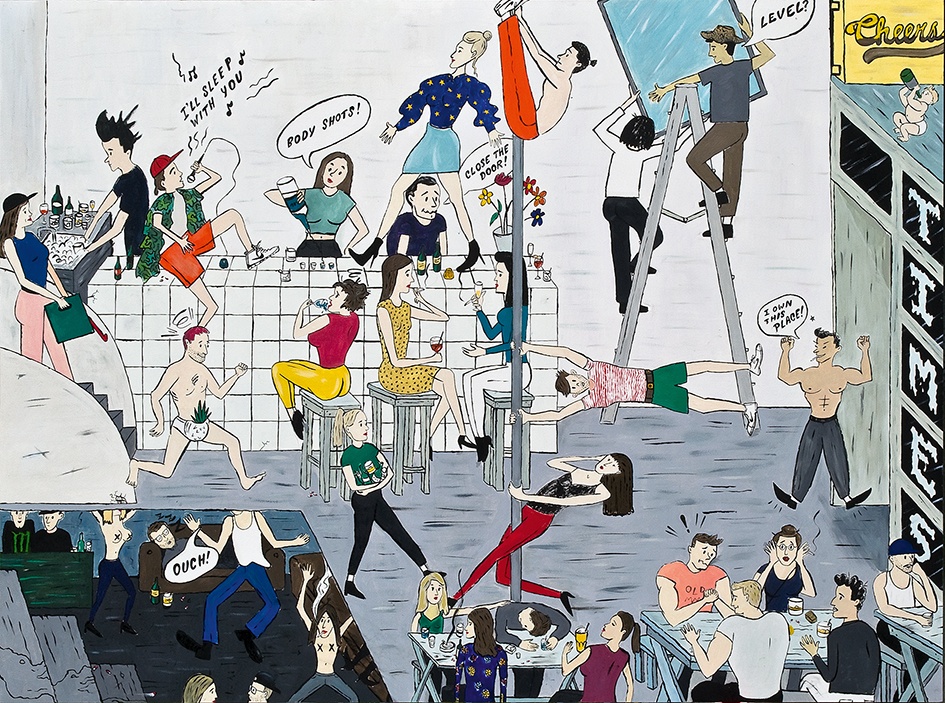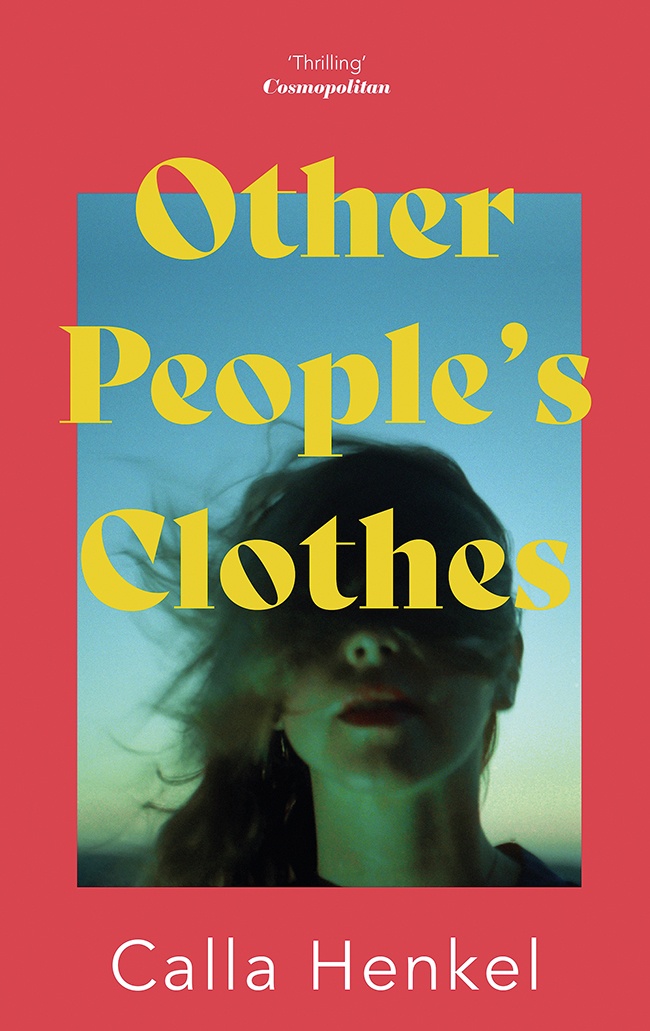THE BERLIN SCENE Nathan Ma on Calla Henkel’s “Other People’s Clothes”

Skye Chamberlain, “Times Painting,” 2012
In 2017, the Hamburger Bahnhof celebrated Berlin’s young talent with its biennial Preis der Nationalgalerie exhibition, and raised eyebrows with its approach: the four finalists for the city’s top contemporary art prize – all women, as the jury were keen to point out, and from around the world – represented a new vanguard, but the artists questioned what exactly this meant. “We take, at face value, the intention of this prize to be to support and give voice to serious artistic positions and practices based in Germany,” they wrote in an open letter released shortly after the award ceremony. “It is clear to us that in a more egalitarian world, the fact of our gender and national origin would be barely noticed. Having it constantly emphasized can only be indicative of how far we are from such an egalitarian world. Furthermore, the self-congratulatory use of diversity as a public-relations tool risks masking the very serious systemic inequalities that continue to persist at all levels of our field.” [1]
Myths are sustained by hope, and the fairy tale of Berlin has collapsed in recent years: the city’s poor-but-sexy reputation has long outsold the opportunities available in a city marred by rising rents, socioeconomic divides, and a growing chasm between the free-spirited post-art-school playground it was once known as and the technocratic start-up accelerator ruled by bureaucrats that it has grown to be. No matter who you ask, the blame lies somewhere else: politicians who privilege padding their wallets over acting with compassion and dignity; an out-of-touch art scene paid for out of the pockets of rich parents; equally out-of-touch US expats who cluck their coffee orders in English on their way to work at Zalando; mega-landlords and their legal teams; the Greeks (somehow); the Germans (regrettably).
But in the art world, the rapidly accelerating changes are hard to ignore: in 2018, a report from the Institute for Strategy Development (IFSE) and the Professional Association of Visual Artists Berlin (BBK) projected that around 90 percent of the city’s artists would be impoverished by old age based on their current earnings and also warned of underreported cases of sexual harassment and winnowing opportunities for exhibition-making, especially for women. [2] That the Preis der Nationalgalerie championed its shortlisted nominees without addressing the root cause of their rarity ineffectually argued that the four artists shattered a glass ceiling without asking who installed it in the first place. In sum, a new question emerged: In a city like Berlin, who owns a story, and who owns a scene?
Other People’s Clothes, the debut novel from the Berlin-based US artist and writer Calla Henkel, builds on this borrowed ground: “I was never good at telling stories, and this one always felt like it belonged to someone else,” Zoe, the book’s narrator, introduces herself from The Spa, a women-only treatment facility on the outskirts of Berlin for those experiencing acute stress and psychological disorders (p. 1). An attending nurse probes her accordingly: “And whose story do you believe you are in right now?” (p. 2). “Yours,” Zoe replies, gesturing to the nurse’s notepad. The nurse asks her to return to the beginning of her story, and then the novel starts.
The Berlin that Zoe inhabits is a gray expanse with slightly more German speakers per capita than New York, and Other People’s Clothes slots into a growing canon of new expat fiction from the German capital, alongside Lauren Oyler’s Fake Accounts and Elvia Wilk’s Oval. Each of these books contends with a city whose reputation is either bloated by or elevated through a long-standing network of English speakers from around the world, depending on who you ask. To varying degrees, they each astutely acknowledge that Berlin has become a place where people move to be annoying – often temporarily – and situate themselves within the open debate over exactly whose fault that is. While Oyler focuses on the present and Wilk trains her eye to the near future of a city in the grips of a housing crisis, Other People’s Clothes turns to the recent past: it’s set in 2009, when a new wave of young Americans (including Henkel herself) made their way to the promised land of cheap rents and never-ending club nights.

With the youthful confidence that comes with being precisely 20 years old, Zoe maps out her mental state through her many grievances: she resents her sleepy hometown of Sebastian, Florida, where nothing really happens and no one really matters; her classmates in New York City can’t take her art seriously, or maybe they won’t, or they just don’t want to; her entitled ex-boyfriend ruined her plans to hide in Helsinki on a year-long exchange; her best friend Ivy is stabbed to death in an apparently random homicide; her boyfriend Jesse loves drunk driving and hates when she’s away. In Berlin, Zoe surmises, everyone is running from something, so she moves to the city to run away from herself.
Zoe finds comfort in her roommate Hailey, the heiress to a supermarket-chain fortune whose taste for lowbrow ephemera baffles the high-minded art scene she longs to be a part of, but who follows Lindsay Lohan’s tabloid appearances like scripture nonetheless. For all her faults, Hailey speaks German and proves to be both resourceful and determined. Like true expats, the pair quickly sort out a sublet where they won’t be asked too many questions. Their landlords are the Becks: Beatrice, an austere author of thrillers whose name is never far from the press, and Janet, Beatrice’s equally severe mother and quasi-manager.
Enthusiastic as they may be, the art students are iced out of the gallery scene for being too young, too naive, and too American, so Hailey and Zoe throw a series of house parties as an extension of their art practice. They call the club Beatrice and refuse to be ignored – either by those who are reluctant to acknowledge they exist or by their landlord, who tells the press that her next work is the story of “two young girls who get wrapped up in partying in a desperate bid for recognition” (p. 223). Their plan works. Gallerists and art-world insiders line up at their door, and the young women are no longer left wanting for weekend plans. Indeed, as they survey the snapshots from a mid-party photoshoot with Purple magazine (again, 2009), the girls gawk at what they see: from behind a bob of black hair, Beatrice herself is there. Zoe and Hailey begin to wonder if they’re being watched, and it visibly irritates Hailey, ultimately pushing her only further. As she tells Zoe early on in their friendship, “At this point in my life, I would never let my image be used in the service of someone else’s narrative” (p. 67). But the story is still unfolding, and as the novel progresses, we watch as the blunt edge of fame tears away at its makers.
As the girls begin to worry their landlord is lifting their life stories for her next blockbuster paperback, the novel’s form unravels: it’s easy to forget who is telling the story (Zoe), to whom that story is being told (a nurse at The Spa), and when it plays out (an unspecified point in the future). The layers of storytelling unfold like a lacework under Henkel’s direction. Beatrice, a makeshift club overpopulated with international twentysomethings, is an obvious stand-in for Times Bar, a project space and bar Henkel ran with her artistic partner Max Pitegoff and artist Lindsay Lawson for a short few months around 2010, closing it before it peaked but after collecting a few press clippings.
Their project agitated a sleepy scene in the German capital, disturbing the art-world hierarchy that foreclosed their inclusion just as Zoe and Hailey aim to do with Beatrice. Yet, in the years since, Henkel, Pitegoff, Lawson, and their collaborators have found fame and success in exhibitions, biennials, and international competitions. In late September of this year, the duo of Pitegoff and Henkel were exhibited as one of the four finalists for the 2021 Preis der Nationalgalerie, alongside Lamin Fofana, Sung Tieu, and Sandra Mujinga, who was awarded the title in October. The highest recognition in all the land was within reach for Henkel, just as her debut novel is being developed for the screen by Unorthodox cocreator Alexa Karolinski. In a certain light, it feels like a coming of age of Berlin’s oft-celebrated and easily mocked international art scene of young English-speaking expats.
Still, the world around us watches as clubs shutter, galleries close, and artists move on to Kyiv or Mexico City. Even before the pandemic, reporters were quick to note big-ticket private collectors were jumping ship, leaving Berlin and its artists, new and old, behind. Perhaps Henkel’s career – Other People’s Clothes included – is a time capsule, and a tale of a city that is no more. Our rents have risen but our wages have not, and the same blame game remains: the capital of cool is collapsing because of tech money, or politicians, or Americans, or Germans – depending on who you ask. We might start to mourn the city we loved or lived in, and the city that Henkel so compellingly chronicles. But we’re still left with one question: In a city like Berlin, who owned this story, and who owned this scene?
Calla Henkel, Other People’s Clothes, London: Sceptre, 2021.
